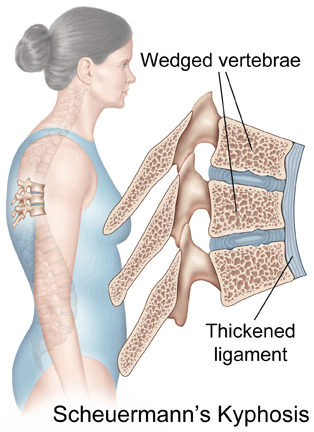Scheuermann’s Disease is an upper backcondition which is characterised by a wedge-shaped formationof the patient’s vertebrae. Thisresults in a postural abnormality whereby the primary feature is an excessive forwards curvature of the upper back (thoracic region).
The spine has many bones (known as vertebrae) each of which connects to adjacent vertebra via the vertebral discs (located centrally) and the facet joints (located on each side of the spine).In Scheuermann’s Disease, the bony growth of the patient’s vertebrae is affected, resulting in abnormal development of the spine along the growth plates.Abnormal changes may also be seen in the junction between the disc and vertebrae in patients with Scheuermann’s Disease.
Patients suffering from this condition have the front side of their vertebrae growing at a slower rate than the back side. These developmental anomalies take place in adolescence when growth is quick and typically results in a prominent forward bend of the patient’s upper back. Although less common, the lower back can also be affected in some cases.
This condition is self-limiting and occurs more frequently in boys than girls. Most patients with the condition may have little or no symptoms and subsequently may not be aware they have it.
Causes
The exact cause of this condition is not yet known. However, some families show an increased likelihood of developing the condition. Researchers have also hypothesised that perhaps the condition arises in association with a pre-existing weakness in the end plates of the vertebrae. Excessive forces placed on the vertebrae may also contribute to the development of Scheuermann’s disease. These forces may involve excessive lifting, bending forwards or slouching. Otherfactors that may play a role in the onset of this condition include:
- Endocrine disorders
- Increased height
- Shortened sternum
- Juvenile osteoporosis
Symptoms
A large percentage of patients with Scheuermann’s disease are asymptomatic. In these cases, the condition may only be detected many years later when symptoms develop in association with increased activity placing stress on the spine or sometimes by chance. One of the primary features of the condition is that the upper back has a marked forward curvature. Correction of the postural abnormality associated with Scheuermann’s disease is impossible.Range of movement (particularly thoracic extension) may also be restrictedoften without the presence of pain. Some patients may experience stiffness, acute upper back pain, and achiness when spinalgrowth is rapid. Symptoms may also increase during periods of repetitious, prolonged or intense physical activities that may involve forceful lifting, excessive bending forwards, adopting poor postural positions, playing contact sports,etc. In some cases, patients may experience lower back, shoulder or neck pain instead of having upper back pain.
Diagnosis
The most commonly used diagnostic tool for Scheuermann’s Disease is an x-ray.
Prognosis
Most people with this condition report little or no symptoms other than their postural abnormality and associated movement restriction. This postural abnormality is typically present throughout life. When symptoms are experienced, this can typically be resolved with appropriate treatment sometimes in as little as a few days or more commonly over the space of approximately two to four weeks. Patients with more severe forms of this condition who do not undergo appropriate treatment may experience symptoms persisting for months or in some cases, years.
Management
Appropriate activity modification advice, patient education, postural correction and progressive physiotherapy exercises to strengthen weak muscles and stretch tight tissue (to reduce the postural deformity) are some of the most important components of evidence based treatment for patients with Scheuermann’s Disease.
How PhysioAdvisor Can Help
Although Scheuermann’s Disease may not be debilitating for some patient’s with this condition, proactive treatment to ensure an optimal outcome is vital. Scheuermann’s Disease requires appropriate advice from qualified professionals to reduce the severity of the postural deformity in later life and minimise or prevent any associated symptoms. This advice can be obtained over the course of numerous in person physiotherapy sessions or alternatively through PhysioAdvisor’s in depth injury rehabilitation guides. PhysioAdvisor’s step by step rehabilitation guide for patients with Scheuermann’s disease has been created by experienced physiotherapists with the goal of empowering patients to take control of their condition. This includes in depth education, lifestyle modification advice, postural correction strategies, self-treatment advice and progressive exercises to ensure an optimal outcome. PhysioAdvisor also has a range of other resources and products that can empower patients to take control of their injury and accelerate their journey to wellness. Visit their website for more information.


















Be First to Comment